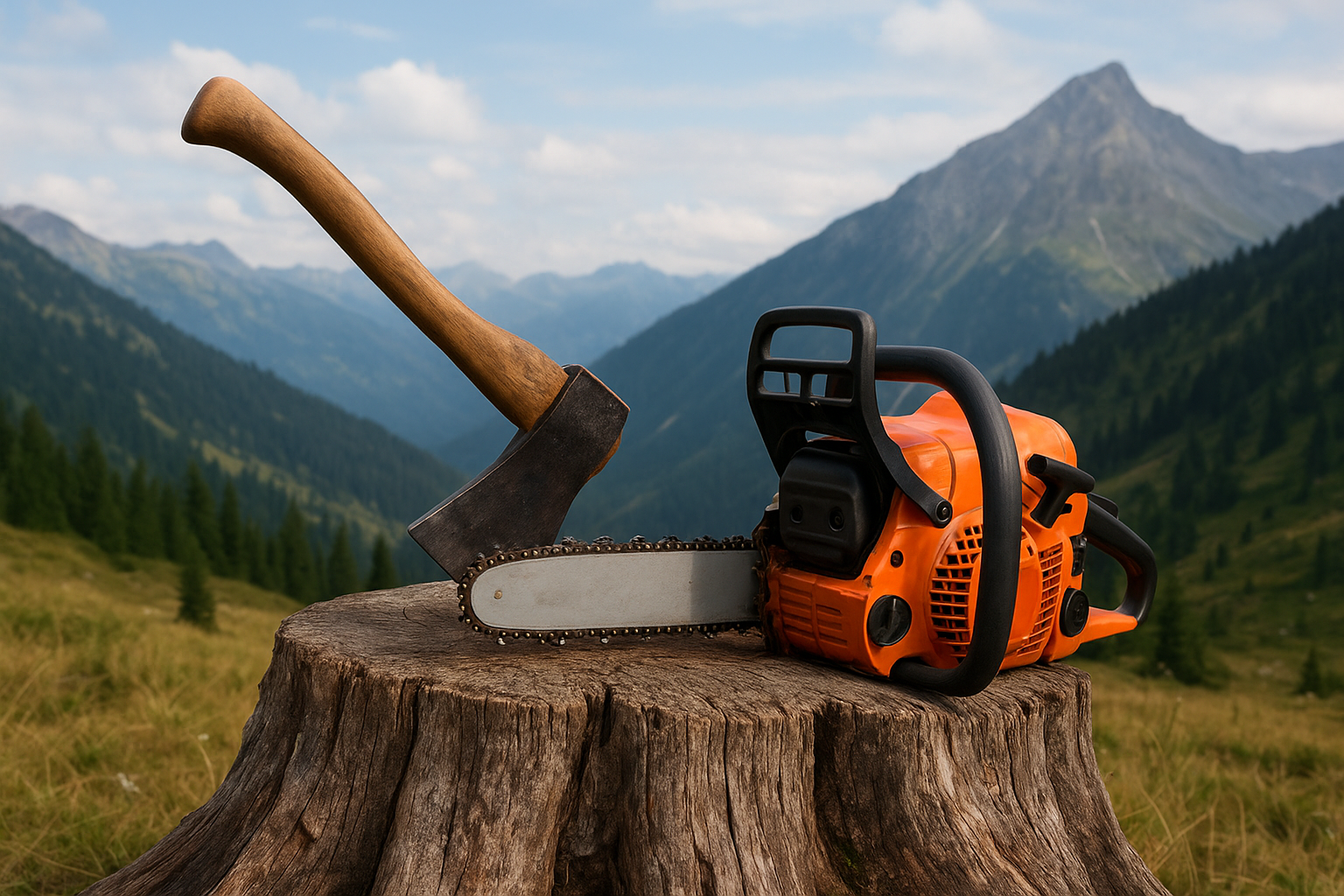When a Chainsaw Is a Better Choice Than an Axe
For generations, the axe has been a trusted tool for felling trees, splitting firewood, and working in the forest. Its simplicity, reliability, and precision make it an essential part of any woodsman’s kit. But as powerful and versatile as axes are, there are times when a chainsaw is simply the better choice.
Whether you’re managing a large property, cutting for firewood, or clearing storm damage, knowing when to reach for a chainsaw instead of an axe can save you time, effort, and even reduce the risk of injury.

1. When You’re Cutting Large or Multiple Trees
Axes excel at felling small to medium trees, but when you’re facing larger trunks or a whole stand of timber, a
chainsaw is far more efficient.
A high-powered saw can handle wide-diameter trees in seconds—something that would take considerable time and effort with even the sharpest felling axe.
If you’re processing a large volume of wood for heating or land management, the chainsaw’s mechanical advantage can’t be matched.
Tip: Always use a saw with a properly sharpened chain and maintain your depth gauges to prevent kickback and overheating.
2. When Precision Is Less Important Than Productivity
An axe gives you control and finesse, especially when shaping wood or splitting with grain awareness.
A chainsaw, on the other hand, is built for
speed and throughput.
If your goal is to buck logs into manageable pieces or quickly clear a fallen tree from a trail, the saw wins every time.
For firewood preparation, pairing a chainsaw with a sturdy splitting axe or maul is often the most effective approach.
3. When Working with Dense or Frozen Wood
Dense hardwoods—like oak, maple, or birch—require much more energy to split or fell with an axe.
Add freezing temperatures, and those fibers become even more resistant.
A chainsaw cuts through both dry and frozen wood with consistent performance, making it the better choice in harsh winter conditions.
If you often work in cold climates, ensure your saw’s bar oil and chain tension are winter-rated.
4. When Time and Energy Are Limited
If you heat with wood or clear land regularly, fatigue is a real factor.
An axe is an excellent workout, but for long days of cutting, fatigue can increase your risk of mistakes.
A chainsaw allows you to conserve energy while maintaining productivity—especially when paired with the right safety gear and regular breaks.
Pro Tip: Always keep a sharp axe as a backup. A chainsaw may save effort, but an axe will always start, even when your saw won’t.
5. When Dealing with Storm Damage or Emergencies
After heavy storms, fallen trees and broken limbs can block access roads or threaten structures.
In these cases, a chainsaw is not just convenient—it’s essential.
A sharp saw lets you quickly clear debris and remove dangerous limbs safely.
Axes are excellent for smaller cleanup tasks, but when you need to move fast, the power and reach of a chainsaw are unmatched.
6. When Splitting Logs Over 16 Inches Thick
Once wood reaches a certain diameter, swinging a splitting axe or maul becomes inefficient.
A chainsaw allows you to
“noodle” large rounds—cutting lengthwise to relieve pressure—before splitting them more easily.
This method is especially useful for knotty or irregular logs that resist clean splits.
Axe and Chainsaw: The Perfect Partnership
While chainsaws shine in power and efficiency, axes remain indispensable for control, safety, and precision.
A professional woodsman—or even a weekend firewood cutter—should ideally have both.
Use your
chainsaw for the heavy work, and your
axe for shaping, splitting, and finishing.
Together, they form the perfect balance of tradition and technology.
Shop Trusted Tools at AXEMAN.ca
At
Axeman.ca, we carry premium axes, saws, and sharpening tools trusted by professionals across Canada.
Whether you need a
Gränsfors Bruk felling axe, a
Hultafors splitting axe, or accessories to maintain your chainsaw, we have you covered.
Every tool is chosen for quality, performance, and longevity—so you can work with confidence, whatever the job demands.













































Leave a comment (all fields required)